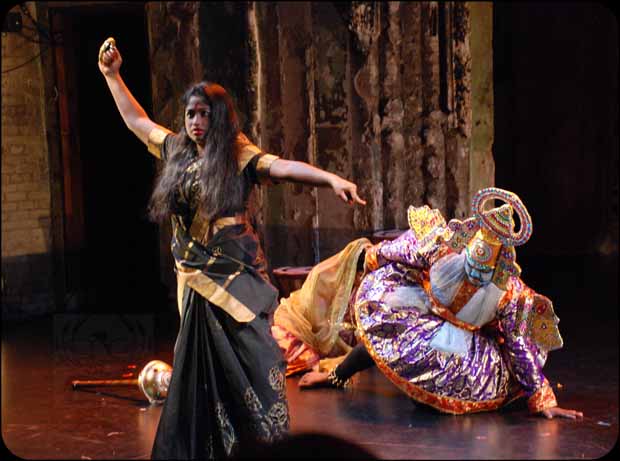The Lost Anklet

Human brain has unimaginable amount of potential and we, as a society, have only scratched the surface when it comes to understanding the fullest potential of it let alone be utilizing it. Experts classify human brain into two major sections; the rear lobe and the frontal lobe. Without getting into too much technicalities, if we have to define these, the rear lobe of the brain is much older in age compared to the front one. The rear lobe was brought-in from the animals as part of the evolution over millions of years. The experts further describe, because of this fact, the rear part of the brain still carries the animal instinct and indulges in violent, inhumane activities. The front portion of the brain evolved as the human kind matured over time and hence is responsible for noble and more subtle thoughts and deeds. The front portion of the brain carries the interest and eloquence towards art, science, math, culture and so on.
Going by this definition, our Thamizh ancestors have evolved and attained this level of maturity thousands of years ago and we have rich and noble literatures as proofs towards this. One such epic, categorized as one of the “Five Great Epics” of Thamizh, is “Silappadhikaram”. Be it the unimaginable talent of art, unparalleled intellect of science or unmatchable accuracy of math – most of these, which are today considered as advancement, were dealt with great amount of detail in this epic. In addition to all of these, this epic has gone on to teaching moral in its purest form, staying completely non-religious. This is a complete poetic rendition in Thamizh which details out the ancient culture, beliefs and practices existed at that time. The crux of the great epic as stated by the author Ilango Adigal himself in the preface translates to English as this: “We shall compose the poem, with songs, to explain these truths: even kings, if they break the law, have their necks wrung by the righteousness; great men everywhere commend chaste of renowned fame; and karma ever manifests itself and is fulfilled. We shall call this epic Silappadhikaram – the epic of the anklet – since the anklet brings these truths to light.”
This profound epic was performed as a theatrical musical amongst Minnesota audience in the recently-held MN Fringe Festival. The drama was indigenously written, produced, screen-played and enacted by MN Tamil Sangam members and volunteers and was staged in form of the ancient art “Therukkoothu” (The Thamizh word which means the dance drama performed in streets). The feather in this crown is that the dialogues were all written in English to enable the local audience understand and appreciate. The songs and music were retained in Thamizh language and backdrop. It was an amazing feast to one’s ears and eyes. The intention of this article is to bring out the 45 minutes experience to the readers of Panippookkal.
The portrayal of the story begins with Kattiyankaran (Thamizh word that refers to “announcer”) narrating the entire story, traversing along with time and the characters. Kattiyankaran intertwines all the happenings throughout the drama with his wise dialogues, personable modulation and witty humors. The drama then introduces the three great empire of ancient Thamizh society – Chera, Chozha and Pandia – appropriately. The introduction paves way for providing the background of the lead characters Kovalan & Kannaki and their life story.
Kovalan – son of a rich merchant – marries to Kannaki and is leading a successful life. While at that, he comes into contact with a stunning beauty – Madhavi, who happens to be a classical dancer – and falls in love with her. He leaves Kannaki alone to be with Madhavi, leads a life with her and gives birth to a child. As time goes by, he gets into a dissent with Madhavi and realizes his wrong-doing of leaving Kannaki and returns back to her. By then, he has lost all his properties and is forced to fight for day-bread. Kannaki’s magnanimity offers him an idea which is to take her expensive anklet, sell it to make money for investment, start a new business and get back into the prosperous life. He feels elated with that idea, heads over to the city of Madurai – the capital city of Pandia Empire – along with Kannaki. While trying to sell the anklet in the streets of Madurai, he gets conspired by the goldsmith of Pandia Empire who has already stolen Queen’s anklet. The goldsmith replaces the stolen anklet with Kannaki’s and masterminds to make the King believe Kovalan is the thief. The king believes the goldsmith and sentences Kovalan to death.
Learning the demise of the beloved husband, Kannaki rages into the assembly of King Pandiya and proves that her husband was mistakenly punished. Back in the days, the anklets used to be filled with priceless gems. The types of the gems differ from society to society. Pandiya Empire fills anklets with pearls while Kannaki’s is filled with Ruby. Kannaki goes onto breaking her other anklet to prove they are different gems and thus the replacement given by the goldsmith was really not the Queen’s. (Imagine the wisdom and the logical mind of the author 2,300 years ago.) Realizing the truth and understanding the grave law-breaking, the king dies immediately and the Queen follows him. Then, the chastity of Kannaki burns the whole city – thus ends the story.
Now that the epic with three major chapters comprising of 30 cantos (divisions) and hundreds of poems and proses have been briefed in two paragraphs, let us get into the briefing of “MN Fringe Festival” and its background.
In 1947, the capital city of Edinburgh in Scotland hosted an “International Festival” with the goal of staging European art forms and to provide renaissance to people who were impacted by the World War II. Amongst several teams that went into participating in this festival, eight of them were denied participation. Instead of getting disappointed and returning, those eight groups decided to perform their arts in the street corners. While the main festival was going on in rich auditoriums, these eight groups were conducting their performances all around town. Gradually, these groups started getting more popularity and appreciations from common public. This put the seed for the then erstwhile “Edinburgh Fringe Festival” which has now spread all over the world. In Minnesota, the contemporary Southern Theaters, which is over 100 years old, hosts the MN Fringe festival since 1994. With its traditional looking theaters, they have been doing a marvelous job of encouraging the budding artists and feeding the appetite of thousands of theatrical art lovers.
It’s now the time to dive into the details of the therukkoothu, “The Lost Anklet”. Watching through the 45 minutes performance took me to thousands of years ago and I was seeing myself amongst that backdrop. The mind-boggling costumes, the diligently-drawn make-ups, the contemporary language and the style, the mesmerizing background songs and music bites that go along, and the performances of all the actors completely sealed the attention of audiences regardless of their age, language, religion and country barriers. Sitting amongst the audience, many of which are from local culture and may not have had any exposure to this story or the culture it portrays, I could sense an immense involvement and a staunch sense of approval and appreciation. This involvement in itself speaks volumes about the dedication of the team and their winning of hearts.
Sachithanandhan, the Director and the brain behind “The Lost Anklet” has clearly far exceeded the expectations of the art lovers. Having watched the Thamizh version of this and his other creations, it is evident to me that he is a true professional who understands this art in its original form and does his best to bring out the fragrance of it tens of thousands of miles away from his home land. He has written the Thamizh songs which are so aptly worded for the situation with a great sense of music in it. He has also sung many of those with a voice that brings out the folk tone so naturally.
Saravanan is the dialogue writer for the English version. He has captured the audience with a pinch of ancient style in the language. Being a Thamizh myself, I was able to relate several Thamizh dialogues and their direct translation. Bringing out some of these traditional conversations without compromising is no walk in the park and Saravanan has done a fine job of this. The dialogues reached out to the hearts of the audience particularly when coming from Kattiankaran, the role that was played by Hanibal. He has been the axle of this big chariot and has done a remarkable job of rolling the chariot along through the duration. The lead character Kovalan was enacted by Kumaraguru whose body language was truly commendable. His facial expressions and the dialogue delivery went above and beyond. The other lead character, Kannaki, was played by one the MNTS Tamil School Students Lakshanya. Her American English added beauty to the dialogues and she has stood out with her performance in the climax scene. She brought in all the emotions needed for that scene, effortlessly. The other actor to be recognized for her unparallelled performance was Meena who played the role of Madhavi. Madhavi’s character is a classical dancer and it was proven without a doubt that Meena is well-versed with Indian classical dance. Her dance performance was heart-winning. Particularly for the song “sOrudai nAdenum pOdhinilE….” where she had to portray all nine expressions (Navarasam) in dance form, her performance was simply superb. It is also necessary to mention that the lyric of this song brings out the nine different expressions so intimately using 9 different raagas (tunes). This was elegantly sung by one of the Carnatic music specialist of the group, Lakshmi Subbu and was composed by Sivanuja. This composition was made even more glorified by the sound of violin by Padhu Govindhan and Mridhangam (a music instrument) by Balaji Chandran. It is important to mention that all of these music were scored and composed by local talents only.
Porkollan (Goldsmith) although had a small role, is truly the villain of the story. The actor has understood this fact and had shown that emotion extremely well with his loud laughter. All other actors, regardless of big or small roles, have all understood their characters and the impact of them clearly and have done justice to their parts. Besides these characters, the portrayal of the three famous emperors Chera, Chozha and Pandiya was another major addition to the drama. The costume for these roles were done following the trend then existed in those three empires. The expressions of the actors, their dialogue delivery and the small little movements which appear like they are dancing – all of these are to be mentioned with keeping the standards way too high. Kopperundhevi, the wife of Pandiya King who dies right after husband’s death, was another character whose depth was understood by the actor clearly and executed naturally. The Jain Frair Koundhi Adigal was enacted by another MNTS Tamil School student Jannis Benjamin and she has portrayed the calm and Godly character so natural.
தி லாஸ்ட் ஆங்க்லெட்
Overall, it was one of the best entertainment musical staged in-front of the Minnesota audience. This has given an excellent opportunity for the second generation Thamizh kids to understand and appreciate the Thamizh Epic in-depth. A huge Kudos to the team that made this possible.
Panippookkal takes this opportunity to congratulate to the entire team that worked on this. Panippookkal also conveys “thank you’s” to MN Fringe Festival organizers, Southern Theaters and all other authorities to make the Thamizh culture and the profound Epic be portrayed in the eyes of the art lovers.
- Madhusoodhanan V.







